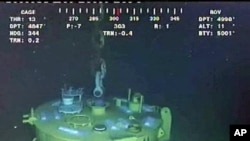The US government's official in charge of the response to the BP well disaster in the Gulf of Mexico, former US Coast Guard Admiral Thad Allen, says the damaged well may already have been killed by the so-called static kill done last week. That involved pumping mud and cement through the top of the well head, 1,500 meters underwater. But, Allen says it is likely a relief well will still be used for a final kill.
Thad Allen says pressure tests to be conducted over the coming hours will determine if cement pumped in from the top has gone down through the annulus, the space between the outer casing of the well bore and the extractor pipe inside. Rising pressure in the annulus would indicate that the relief well drilled into the well below the seabed is necessary for a final kill. But steady pressure could indicate that the space has already been filled with mud and cement, plugging it permanently.
Allen says what is important is not how the well bore is plugged, from top or bottom, but whether or not the well has been killed. "A bottom kill finishes this well. The question is, has it already been accomplished through the static kill or what do we need to do ensure that the annulus has no communication with the reservoir. That is all we are trying to do here is to make sure that no chance that hydrocarbons come up through the reservoir, either through the well casing or the annulus itself," he said.
Some officials in the Gulf region have been expressing concern that operations aimed at completely killing the damaged well could end early, without the so-called bottom kill that both US government officials and BP officials have said would permanently seal the well.
Thad Allen says there is a low probability that the relief well will not be needed, but he says he cannot rule out that possibility. In the meantime, he says, crews are getting back into position after a few days of delay caused by tropical storms moving through the area. "As we have the weather pass by, we will bring our equipment back in to areas where we had evacuated from behind levees and we will be ready to move on with our response," he said.
Although the well is no longer leaking oil into the Gulf of Mexico, officials in nearby coastal states are dealing with damage done to marshes and beaches by the oil slick that resulted when an explosion and fire destroyed the Deepwater Horizon drilling rig on April 20. The rig was owned by Transocean, a Switzerland-based oil services company, and operated by BP, one of the world's major private oil companies.
BP has agreed to put $20 billion in a special fund established by the US government to compensate people in the Gulf region affected by the spill.
Officials estimate that the leaking well spewed 4.9 million barrels of oil into the Gulf of Mexico before the leak was stopped on July 15 by closing off valves on a cap placed over the well head. That, however, was considered only a temporary solution and experts said a permanent fix would only come about through a top kill, or static kill, as well as a bottom kill, achieved through drilling a relief well.
Preparations Continue for Final Kill of Damaged BP Oil Well
- By Greg Flakus







